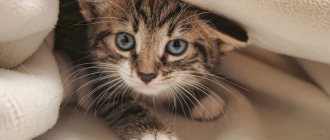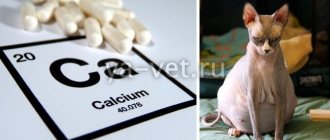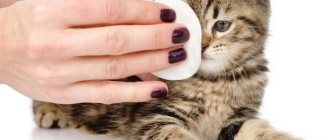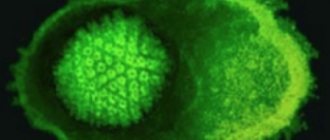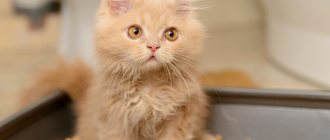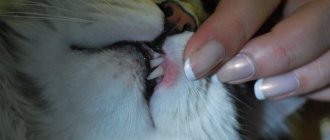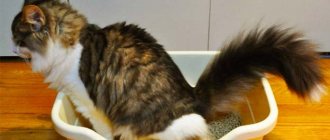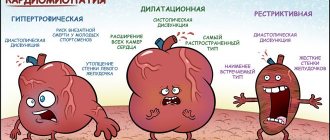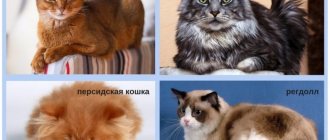Often, even truly purebred elite cats give birth to several kittens that are strikingly different from their brothers. They look much weaker, their fur does not shine with cheerful tones, they have loose stools and even vomit. Such kittens will gain weight poorly, will not be active, and will lag behind in development. All these symptoms belong to a disease called rickets. Now you can recognize the disease in a timely manner, but still professionals pay much more attention to this, they also know that you need to seek help in treating rickets immediately from experienced specialists, self-medication rarely helps here, but the help of specialists will help quickly. to correct.
General information
Due to the low calcium content of meat and offal (and this is very often forgotten), secondary rickets and osteoporosis can become a serious problem for many domestic cats.
Congenital rickets is much less common, but leads to more severe consequences for both kittens and their mothers. The same applies to animals whose diet is not balanced in phosphorus: its too high or too low levels also impair the absorption of calcium, which in the long term leads to very sad consequences.
This feeding results in poor bone mineralization in young animals or excessive bone resorption in mature animals. If nothing is done, the bones of such cats will further break from the slightest mechanical impact. There may be cases of osteomyelitis and other pathologies that are fatal to the life of the animal.
Calcium, phosphorus and vitamin D are the elements whose ratio in food for adult cats and kittens should be ideal (or at least close to that).
It is for this reason that veterinarians strongly advise using specialized food for feeding at least kittens and pregnant cats, in which all these ratios have already been selected in the most optimal way.
It is important to remember that vitamin D is not synthesized in cat skin, and therefore walks in the fresh air are almost useless when treating rickets in animals (but for the best condition of the cat, they should not be neglected).
Thus, the only source of everything necessary for bone tissue is exclusively the food that the owners feed their pet. There are physically no other opportunities to replenish the lack of calcium and vitamins in an animal. This circumstance once again indicates the extreme importance of normal feeding of cats.
Dangerous consequences and complications
In addition to disability and severe pain due to chronic inflammation of joint tissues, delayed treatment can lead to other dangerous consequences associated with disruption of adjacent organs. These include:
- Iron-deficiency anemia;
- severe convulsive seizures, reminiscent of epileptic attacks;
- heart failure;
- impaired absorption of nutrients, reducing immunity;
- oxygen starvation.
Due to severe deformation of the pelvic bones, a sick cat will not be able to bear and give birth to healthy offspring. For this reason, it must be excluded from breeding.
Reasons for the development of rickets
The main problem facing a veterinarian involved in the treatment of rickets or osteoporosis is poor mineralization of bone tissue. The degree of pathological changes depends on the specific cause of the pathology, but in most cases it is necessary to immediately stop further depletion of calcium reserves by improving its absorption in the gastrointestinal tract.
The faster the specialist manages to establish normal metabolism, the faster the animal will recover.
“Dietary” calcium is approximately 90% absorbed in the cat’s ileum. But the actual degree of absorption depends on the level of vitamin D in the pet’s body.
Note that its excess is even more dangerous than its deficiency, since in this case many insoluble calcium salts are formed, washed into the external environment along with excrement. Severe gastroenteritis also causes decreased absorption of calcium ions.
The root causes of rickets (or osteoporosis) may be the following factors:
- When vitamins are present in animal food, they are in residual quantities.
- There is too little (or too much) calcium in your pet's food.
- For diseases of the gastrointestinal tract.
- Kidney pathologies contribute to these ailments. If you see these symptoms in a pregnant cat, take her to the vet immediately! Without immediate help, both the animal itself and all its offspring may die.
- Disturbances in the functioning of the endocrine glands can lead to similar consequences.
- In kittens, the disease is often caused by weaning them from the cat too early. The animal’s body does not have time to stock up on sufficient amounts of calcium.
Factors provoking secondary rickets
The main factors provoking secondary rickets are:
- Violation of the conditions of care and maintenance of kittens and young animals. These include: keeping them in conditions of lack of sunlight, extreme humidity and stuffiness.
- Feeding babies not with mother's milk, but with substitutes. This provokes metabolic failure, forming low immunity and laying the foundation for future health problems (including rickets).
- An early transition from milk feeding to solid food is also undesirable.
- An unbalanced kitten diet and the lack of vitamin and mineral supplements (which includes vitamin D) when switching to adult food often lead to rickets.
- Diseases of the gastrointestinal tract, in which the process of absorption of nutrients through the intestinal walls is disrupted, kidney pathologies, disruption of the endocrine glands - all this provokes the development of rickets in kittens and osteoporosis in adults.
Symptoms of rickets in adult cats
An experienced specialist will easily notice a reduced degree of bone mineralization on an x-ray. In addition, X-rays clearly show the destruction of bone growth zones. Because of this, in advanced cases, young animals, even with a satisfactory result of treatment, will no longer be able to reach the same size as their healthy relatives.
Visual examination shows similar results:
- Strange bending of the limbs . In severe cases of rickets or osteoporosis, the cat looks like an “old sea wolf”, as its paws are strongly arched.
- Chest deformity. This is due to the fact that the ribs, being quite thin and lamellar bones, are the first to be hit by a lack of calcium in the body.
- Scoliosis or lordosis. Simply put, a sick cat's spine is noticeably deformed.
- Sagging belly. Associated with both deformities of the spinal column and impaired rigidity (contractility) of the abdominal muscle tissue. The fact is that normal muscle functioning also directly depends on the normal amount of free calcium in the blood.
Laboratory diagnostic methods
Rickets in cats is diagnosed at the stage of mild symptoms, for which blood is taken from the animal for biochemistry and general analysis. The pathology will be observed in a significant decrease in calcium and phosphorus, a significant increase in alkaline phosphatase, and a decrease in blood clotting.
When making a diagnosis, the veterinarian prescribes an x-ray, which should show bone loss, curvature, thickening and deformation in the vertebral region and chest. A radioisotope study will also show all changes in the skeleton.
Systemic disorders can be diagnosed using abdominal ultrasound and electrocardiogram.
Hyperparathyroidism is very similar to rickets, i.e. dysfunction of the parathyroid gland. This disease also affects muscle tissue and the hepatorenal system. An ECG and ultrasound will show the difference.
Signs of rickets in kittens
How can you tell if a kitten has rickets soon after it is born? In fact, there are no particular difficulties with this. If the pathology is congenital, then the appearance of the animal is sad.
- Babies have strangely curved and seemingly “twisted” paws.
- The kittens are constantly squeaking and literally screaming. This happens because they are simply in pain.
- Pets with rickets are far behind their healthy relatives in development; their eyes open very late. The claws of these animals are soft, sometimes they literally peel apart before our eyes.
If you see signs of rickets in a kitten, do not rush to immediately take him to the veterinarian. Take his mother (and all his brothers and sisters) with you. If a baby who EATS only mother's milk has problems with a lack of vitamin D and Ca, then the cat's health is probably not all right. In a word, the help of a specialist will not hurt all your pets.
Animals at risk
Rickets is primarily susceptible to young domestic cats aged from birth to six months. The risk group includes kittens born on the street from
stray cats.
When adopting a foundling, the future owner must be aware of the risk of developing pathologies of the musculoskeletal system in such pets in the near future.
There is a high probability of metabolic disorders with rachitic manifestations in artificially fed kittens. The use of cow's milk and infant formula for these purposes leads to an imbalance of protein components, mineral elements and vitamins in a growing body.
Most often, kittens born in the spring are susceptible to rickets. This is due to a deficiency of sunlight, as well as vitamins in the diet of the mother cat and young animals.
Diagnosis
As we have already indicated above, a sufficiently experienced specialist will be able to determine the presence of the disease by its specific signs. Despite this, it is much preferable not to wait for the appearance of pronounced symptoms, but to diagnose rickets by changes in the biochemical characteristics of the blood .
A characteristic feature of many cases of rickets is a sharp and very strong increase in the level of parathyroid hormone in the blood serum. Interestingly, at the same time, the thyroxine level (as a rule) remains within normal limits.
Based on similar results of many studies, some veterinarians have concluded that chronic hyperparathyroidism (increased secretion of parathyroid hormones) is directly related to rickets.
In addition, an X-ray examination is required. X-rays will show a weakening of the bone structure, as well as the presence of deformations and thickening of the bones. One of the characteristic signs of rickets is the appearance of “rosaries,” that is, thickenings at the ends of the ribs.
Description
There are 2 forms of hyperparathyroidism:
- Primary - characterized by increased levels of parathyroid hormones. The disease occurs due to dysfunction of the gland itself. This form of pathology is very rare. Typically, primary hyperparathyroidism is diagnosed in older cats with parathyroid hyperplasia or enlarging tumors.
- The secondary form is the most common. Its development is caused by kidney disease, in which the balance of electrolytes in the body is disturbed. As a result, the amount of phosphorus increases and the level of calcium in the blood decreases. To correct the imbalance, the body begins to intensively produce parathyroid hormone. Against the background of such disorders, there is a decrease in the level of calcitrol, which is the active form of vitamin D. It is produced in the kidneys and helps improve the absorption of calcium from the intestines. Its deficiency in the body leads to disruption of the process of bone mineralization.
A nutritional form of hyperparathyroidism, caused by excess phosphorus in the diet, is common in kittens. For normal formation of bone tissue, the ratio of calcium and phosphorus in the skeleton and blood must be constant.
An imbalance occurs as a result of the kitten's intake of predominantly meat food, which is rich in phosphorus but contains little calcium. A cat is a predatory animal that, under natural conditions, eats its prey along with the bones, thus replenishing its body with calcium. Pet owners often feed them beef, chicken, liver, and sausage. Introducing cottage cheese and milk into the diet does not save the situation, since the level of phosphorus in dairy products is 2 times higher than the amount of calcium.
Kittens are susceptible to the disease due to the fact that the growing body requires tens of times more calcium compared to an adult. Most often, Maine Coons, Siamese, British and Scottish kittens suffer from hyperparathyroidism.
The progression of the disease leads to the formation of multiple pathological bone fractures - both folded and microfractures, which are not visible on x-rays. Damage to the pelvic bones causes severe deformation of the pelvis and disruption of the bowel movement. Fractures or cracks in the spine cause neurological disorders.
Treatment of rickets
The sooner the owner takes some measures to stop the disease, the more likely it is that it can be stopped before serious consequences occur. Treatment should be started as early as possible!
- It is necessary to place your pet in a spacious, bright, well-ventilated room. In such conditions, the general condition of the animal will certainly improve.
- It is advisable to walk the cat more often. It is very advisable to play with the kitten more often. The key to his health (including) is the normalization of physical activity.
Proper nutrition
Without proper nutrition, recovery is impossible. If your pet tolerates milk normally (and not all cats digest it), you can feed it cottage cheese or other fermented milk products.
It is allowed to include egg yolk in food, as well as fish (it is rich in phosphorus and other microelements). In ideal cases, we advise you to completely switch to special medicated food.
But we would not recommend mixing the latter with “natural” food, since in this case it is impossible to guarantee the exact ratio of nutrients, macro- and microelements in the animal’s food.
With kittens it's a little more complicated. It is advisable to transfer them to artificial feeding with special milk formulas. Never use cow's or goat's milk for these purposes.
Pharmacy and folk remedies
But what if the animal’s condition needs to be stabilized immediately? To do this, calcium gluconate is administered subcutaneously or intravenously, the specific dosage of which depends on the data obtained from a biochemical blood test. The effect of treatment is checked by regularly conducting biochemical blood tests.
- An oil solution of vitamin D 200 IU is given orally. In addition, it can be administered subcutaneously in the same doses.
- In the simplest cases, it is enough to give the animal ten drops of Tetravit.
- Capsulated fish oil gives a good effect (one capsule per day per animal for a week).
To normalize the functioning of other body systems, the following steps are taken:
- If a cat has digestive problems, you need to prescribe medications with digestive enzymes (in the form of the well-known “Mezim” or “Pancreatin”). The dosage should be selected based on the results of clinical studies. At home, you can also use flax decoction, which also improves the digestion process.
- Caffeine sodium benzoate can be used to support cardiac activity.
- If the cat's joints are damaged, chondroitin is prescribed.
- It is recommended to prescribe general strengthening compounds. If you want to use folk remedies, give your cat a drop of Eleutherococcus extract per day. This remedy accelerates and normalizes metabolism, helping the animal’s body recover from a serious illness. In addition, it simply improves the well-being and general condition of your pet, which is also important.
Remember that in advanced cases, curing rickets in a kitten can be difficult, if not impossible.
How to make a diagnosis?
Only a veterinarian can make an accurate diagnosis. Make an appointment with a specialist to undergo a complete examination. The doctor will examine the kitten and prescribe the necessary tests:
- biochemical analysis of blood and urine,
- X-ray examination of the spine,
- histology of bone tissue.
This is necessary to exclude the possibility of the kitten developing diseases with similar symptoms (for example, false rickets or polyarthritis).
Prevention of rickets
Prevention of rickets is much better than its treatment (which does not guarantee a positive outcome). To do this, you need to follow a number of not too complicated rules:
- A cat should be bred no more than twice a year. It’s even better if within a year and a half the pet had no more than two matings that ended in pregnancy. Consult with a specialist when choosing the most balanced diets. If your cat has gastrointestinal or kidney diseases, mating should not be allowed.
- Kittens should be picked up no earlier than ten weeks, but no later than 12 weeks.
- If possible, take walks with your pet more often.
- Provide “self-employment” for the animal. Buy more toys, let your pet play more, as movement is vital for him.
- Vaccinate your cat on time and take him to the veterinarian at least once a quarter for a preventive examination.
- Give your cat one fish oil capsule every couple of months. The course of preventive treatment is exactly one week. It is also permissible to include one drop of Tetravit in the diet (in the absence of fish oil capsules) during the same period.
Preventive actions
What to do to protect your pets from such an insidious disease as rickets:
- Responsibly approach reproduction. Select partners for your cat wisely: avoid mating sick individuals and relatives. Limit the number of cat pregnancies - no more than twice in three years.
- Organize enhanced, balanced nutrition for the pregnant cat with high-quality food.
- Walk the cat “in position” more often during the daytime.
- Follow the hygienic rules for raising kittens: maintain the required temperature and humidity in the room, arrange regular ventilation. The normal temperature for newborns is 31°C, then it gradually decreases by 4°C. Humidity – 55-65%.
- Provide young animals with adequate sun exposure.
- Feed “artificial” ones only with special high-quality mixtures for kittens.
- Wean kittens from mother's milk only at the age of 2.5 months.
- Conduct timely deworming and vaccination.
- As prescribed by the veterinarian, give vitamin-mineral complexes with microelements involved in the formation of the bone apparatus.
- Provide kittens with sufficient physical activity. Let them play with mom and other kittens. Play with them more.
Choose the best toys so that kittens can play more.
Remember that rickets (hypovitaminosis D) is often the result of insufficient attention to furry pets. This disease does not forgive human carelessness and negligence. If left unattended, it progresses quickly and can lead to sad irreversible consequences.
Video
Main complications of rickets
The danger of rickets is not only the destruction of the musculoskeletal system: this disease affects the entire body of the animal. Even moderate cases can lead to cat disability. Due to pain and curvature of the limbs, the pet moves less, and the respiratory and cardiovascular systems suffer. In addition, if the pelvic bones are deformed, cats subsequently cannot give birth normally.
If the disease has led to deformation of the chest, the heart is under attack. There may be disturbances in its rhythm, shortness of breath, congestion and edema. Since calcium, which is sorely lacking in rickets, also plays an important role in the functioning of the nervous system, seizures similar to epileptic ones are possible.
Symptoms
Epilepsy
Diabetes mellitus in cats
Hypertrophic cardiomyopathy
Based on the symptoms of rickets in a kitten, treatment prescribed by a veterinarian in a timely and correct manner leads to the animal’s recovery. The depressed state must not be allowed to last too long, otherwise the consequences of the illness may be more severe.
Experienced breeders and veterinarians are unanimous in the statement that the main cause of rickets in offspring is a poorly balanced diet of the mother cat during the gestation period. Low content of amino acids, mainly taurine, leads to pathological development of fruits.
Disrupted metabolic processes provoke a lack of proteins, fat-soluble vitamin E, and ergocalciferol, which also negatively affects the development of kittens in the womb.
A symptom that attracts attention is a violation or absence of the sucking reflex in a kitten that is not able to find its mother's nipple on its own. Such a baby is weakened, moves little, and is exhausted.
If the symptoms of rickets in cats worsen to the point of modification of the skeleton, then it will be almost impossible to eliminate all the consequences. Lethargy, loss of body weight with excellent appetite should immediately alert the owner.
Symptoms of rickets in kittens include:
- unhealthy thinness with a large and bloated belly;
- unsteady walking: unsteadiness of gait due to poor development of the musculoskeletal system;
- inflammation of the pancreas, when enzymes for digesting food are poorly produced;
- shortness of breath due to myocardial insufficiency;
- compared to its peers, the kitten grows very slowly;
- a kind of “rosary” is observed - thickening of the joints of cartilage and bone tissue on the ribs (when stroking under the palm, you can feel the balls on the sides of the kitten’s ribs);
- the tubular bones of the limbs have “bracelets” - thickenings at the ends;
- the spine visually changes - the back sags;
- teeth change very slowly, much later than expected by age;
- the paws become uneven, then their curvature and lameness are possible;
- abnormally high appetite.
With rickets, the kitten will remain motionless for a long time. Due to thinness and lack of nutrients, muscles atrophy, and fragile bones are susceptible to fractures. Muscle cramps and ligament tears may occur.
Rickets has a destructive effect not only on the musculoskeletal system, but also on many other systems and organs: nervous, digestive, cardiovascular. Kittens with rickets often experience anemia and heart failure. A disturbed nervous system malfunctions in the form of frequent convulsions and seizures, the intensity of which often leads to the death of the pet.
